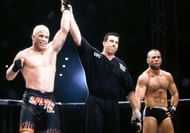Champion

Seven months after the Shamrock fight, Ortiz faced off with Brazilian Vale Tudo fighter Wanderlei Silva for the vacant title at UFC 25 in Japan. Silva didn’t quite have a fearsome reputation at that point but was still seen as a top-level fighter.
Ortiz was able to use his wrestling, size and strength to ground the striker and work him over for a unanimous decision. It was this fight that UFC fans – myself included – always pointed to when the more PRIDE-biased fans would try to claim that their promotion had the best 205lbers in the sport.
Get the latest updates on One Championship Rankings at Sportskeeda and more
A title defence against the much smaller Japanese fighter Yuki Kondo followed, but soon after that, the UFC was purchased by new owners. And here’s where Tito gains massive credibility as one of the most important figures in MMA history.
At the time, Ortiz’s manager was none other than Dana White, who was essentially an unknown. When White heard that the UFC’s owners were looking to sell, he contacted childhood friends Lorenzo and Frank Fertitta, who ran Las Vegas’s Station Casinos.
The brothers purchased the UFC under the Zuffa banner and installed White as the promotion’s new president. If Dana hadn’t been managing Tito and Tito hadn’t gained stardom as the UFC’s top fighter, would Zuffa have ever stepped in to rescue the promotion? I think it’s doubtful.
Today’s history books like to claim that Tito’s feud with Dana began there, as White was forced to resign as Tito’s manager due to his new position. Personally, though I don’t buy that – at that time Tito was the UFC’s poster-boy, their biggest star, and Zuffa wanted to keep it that way.
One shred of evidence for this? Look at MMA’s weight classes. They’re well-established today, but back in 2001 when what we now know as the ‘Unified Rules’ were put together, one of the changes came in Ortiz’s division.
Middleweight, as it was once known, became Light-Heavyweight, and more importantly, the upper limit was changed from 199lbs to 205lbs. Some would point to the fact that 199lbs was too close to the new Middleweight limit of 185lbs, but the long-standing rumour is that Ortiz had told Dana and the Fertittas that 205lbs was easier for him to make, and so they convinced the rule-makers to go with that instead.
2001 was Tito’s year in the UFC. With the new owners backing him and sinking plenty of cash into the promotion, Ortiz was pushed as the biggest star in the game. He was the one who was given personalised Limp Bizkit entrances, pyro, the works.
And he lived up to his side of the bargain, taking out Evan Tanner, Elvis Sinosic and Vladimir Matyushenko to take his number of title defences up to four. A knee injury would derail him going into 2002, but his biggest fight was firmly on the horizon.
